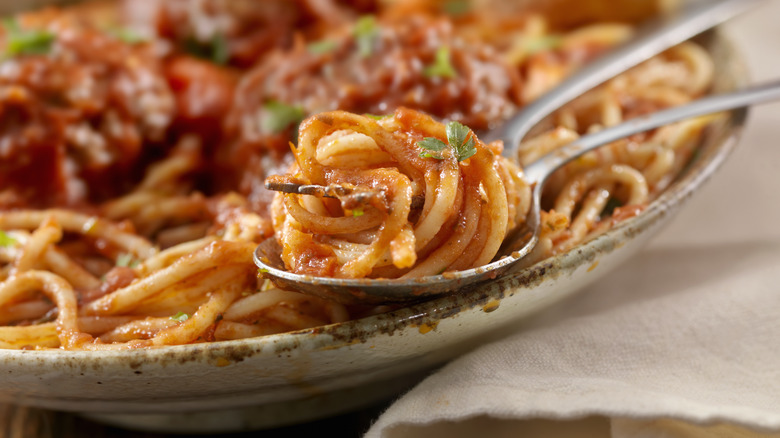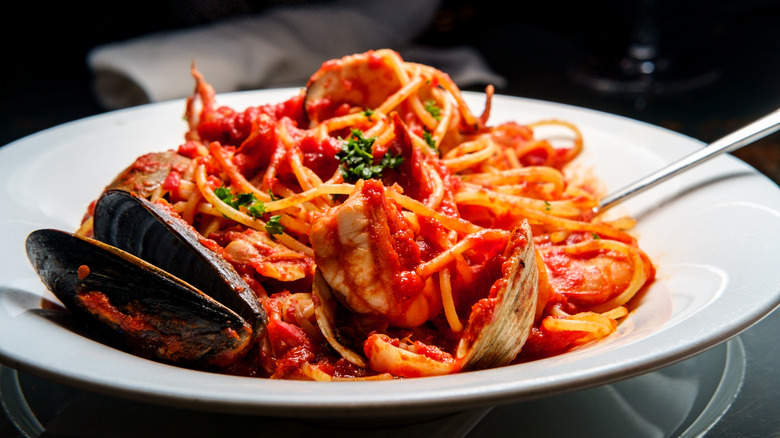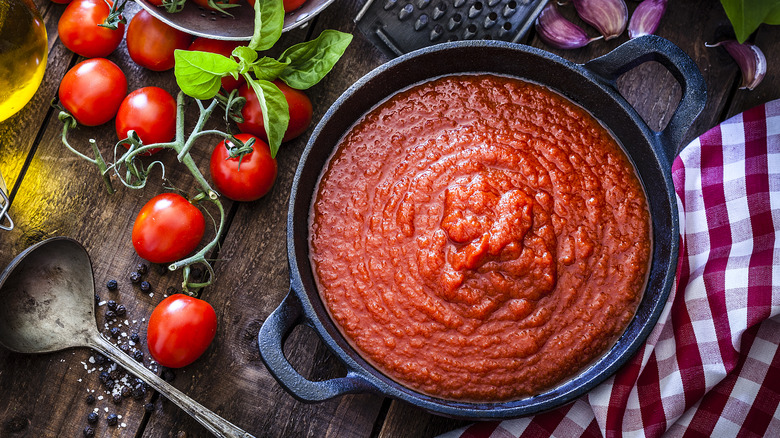If You Order Marinara Sauce In Italy, You May Not Get What You Expect
Dining out at a restaurant in Italy isn't like eating at Olive Garden. If you don't know much about Italian cuisine there are bound to be dishes you don't recognize on the menu. You may find yourself gravitating towards an item called "pasta alla marinara” considering it has a name that sounds familiar. But contrary to what you might expect, you won't be served a plate of noodles topped with red sauce. Instead, there's a good chance you'll receive a different pasta dish entirely — one that includes a sauce made with shellfish and other briny ingredients.
What Americans know as marinara does have a place in Italian cuisine, but it's called something else. It's known as pomarola, or salsa di pomodoro alla Napolitana, which translates to Neapolitan tomato sauce. Not to be confused with pomodoro sauce, pomarola sauce cooks down for a long time and the tomatoes are usually blended rather than left chunky. They are similar and both tomato-based, but if you want "marinara" in Italy, you'll want to order pomarola instead.
American vs Italian marinara sauce
Despite having the same name, American marinara sauce and Italian marinara sauce differ significantly in ingredients and flavors. Both call for tomatoes, but they're more of a secondary ingredient in Italian marinara sauce. Instead, it's primarily made up of seafood including shrimp, scallops, clams, and mussels, which are enhanced with the flavors of garlic, parsley, basil, and dry chili. Some iterations of the recipe also use anchovy along with olives and capers.
American marinara sauce on the other hand has a completely different flavor that is nowhere near as briny or complex. In addition to the standard tomato, basil, garlic, and oregano combination that can be found in most recipes, oftentimes onions, red pepper flakes, and black pepper are added. However, even with these additions, the flavor of American marinara sauce is heavy on the tomatoes. Seafood and any other proteins are typically absent from it, distinguishing it from a Bolognese sauce or pasta puttanesca.
Why American and Italian marinara sauce are so different
The distinction between American and Italian marinara sauces can potentially be traced back to the origins of the word "marinara" itself. In Italian, marinara can best be translated to "seafaring" or "mariner-style," referring to its historical connection to sailors who relied on this sauce during extended sea voyages, dating back to the 16th century. Some say that the sauce was made with ingredients that were as simple as possible, because it was more practical for life at sea. Other sources claim the sauce was prepared after these sailors came home, and that the simplicity of the components was due to the fact it was the easiest sauce for housewives to make upon their unanticipated return. The other theory is that fishermen made it out of convenience, using whatever seafood they had easy access to in order to make a sauce.
The presence of marinara sauce in both Italian and American cuisine suggests that there may be elements of truth in each narrative. As for how marinara came to be known as such in U.S., it dates back to the late 1800s and early 1900s, coinciding with the wave of Southern Italian immigration. It's unclear whether these immigrants had always referred to it as marinara or if the Italian seafood marinara gradually evolved into the tomato-based sauce known today. But regardless of its murky origins, it's best to order it by a different name when in Italy.


